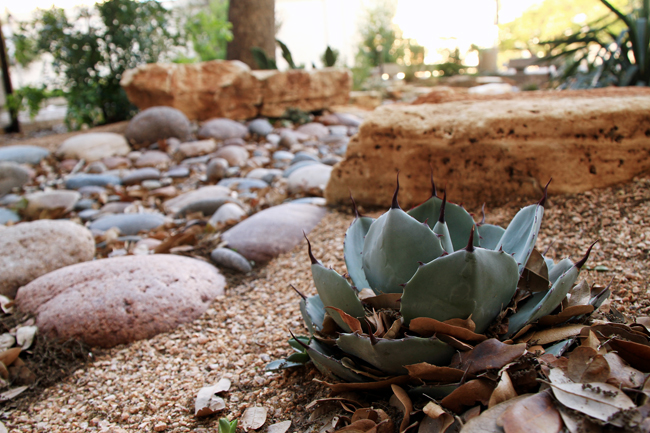Walking to class, students might see more pebbles and agave plants and fewer grassy areas along buildings as UT landscapers are opting for more native Texas plants and low water-use landscaping to reduce irrigation water use.
Facilities Services manager John Burns said with an ongoing drought and city water restrictions, landscapers are trying to keep the University’s gardening attractive without wasting water on upkeep by using low-water native and adapted plants that do well in this climate.
Burns said they are also xeriscaping, which replaces grass with stone or rocks and desert-type plants that need minimal water.
“They will survive longer with less water,” Burns said. “Being native or adapted they already use less water than other plants but they still need some extra.”
Markus Hogue, irrigation and water conservation coordinator, said at least six areas on campus are using xeriscaping techniques to cut irrigation to a fraction of previous water use.
“We’re collecting data and finding high water use areas. We changed out the landscaping so that it doesn’t require as much water as before,” Hogue said. “We’re putting in drought tolerant material that is able to survive the environment.”
The area outside of the Harry Ransom Center is one of the areas xeriscaped. Facilities worked with the Green Fee Committee, a program that awards funds to student led environmental science projects on campus.
Karen Blaney, Sustainability Operations assistant manager and Green Free program coordinator, said the student plans for xeriscaping the center were implemented by UT landscapers. Blaney said about 10 percent of the project proposals submitted aim to conserve water use.
“Students had the idea to change the area near Harry Ransom, which wasn’t very attractive and the Green Fee project beautified that space,” Blaney said.
Blaney said the program is working with students toward a plan to revitalize the area around Bass Concert Hall and make it a low water use landscape. Hogue said the trees also help cut costs.
“Our trees hold the moisture underneath it, so we were able to start pulling back certain areas that were being over watered. We’re trying to be efficient,” Hogue said.
Burns said most of the trees in the center of campus were planted in the 1930s, and keeping them healthy is important for the visual appeal and protection from the sun.
Burns said with another hot summer expected to worsen the Texas drought conditions and potentially reduce the University’s water budget from the city, maintaining irrigation water for the trees on campus will be his main priority.
“It could be bad this year,” Burns said. “We will take as many heroic steps as we need to try to maintain our trees. That will be our focus and watering those can help the landscape around them. Most of the trees on campus are native trees, but in nature we’re losing native trees because of this extended drought, so we still have to put additional water on them.”





















